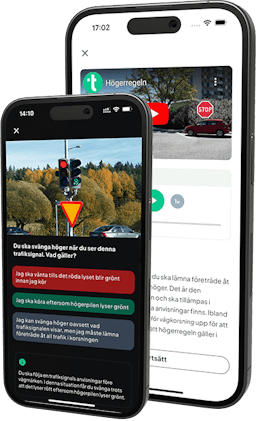Permitted Vehicles
Only motorised vehicles designed to drive at speeds of at least 40 km/h (such as goods vehicles, cars and motorcycles) are permitted to drive on motorways (A) and clearways (B).

Not permitted:
- Cyclists
- Pedestrians
- Mopeds (even though they may be designed to drive faster than 40 km/h)
- Tractors
- Motorised equipment. Exception: Motorised equipment in class I, such as mobile cranes, can be driven here.
Keep in mind that motorway entries are also counted as part of the motorway, which means it is not permitted to cycle or walk along motorway entries.
Rules for Motorways and Clearways
To increase accessibility and reduce the risk of accidents, there are specific rules for driving on motorways and clearways:
- Stopping and parking: It is generally prohibited to stop or park. It is only permissible to park at areas where there are Picnic Area or Parking signs.
- Reversing: Reversing is not permitted. If you miss an exit, take the next exit, turn around and come back.
- Turning: Turning is not permitted. It is possible to turn on motorways in certain areas, but these places may only be used by the police and road maintenance vehicles, etc. If you want to turn, use the exits.
- Emergency stop: If making an emergency stop (due to engine failure, for example), you should position your car on the hard shoulder and set up your warning triangle so that other drivers will notice you in good time.
- Towing: Towing is not permitted.
- Hard shoulder: The hard shoulder should only be used in an emergency situation; i.e. when necessary to avoid an accident.
Motorway Entry
Most motorway entries have an acceleration lane. This is a stretch of road where you can accelerate in order to reach the right speed for the motorway without disturbing other traffic. Indicate in good time, adjust your speed so that you can drive into a gap in the traffic and leave the acceleration lane as quickly as possible.

At motorway entries, neither you nor road users on the motorway have a duty to give way; there is mutual interplay between both sides. Vehicles on the motorway also need to adjust their speed in order to facilitate your entry. If possible, vehicles on the motorway can also facilitate entry by changing to the left lane.
Driving on Motorways and Clearways
Distance
Given that vehicles are being driven at high speeds, it is important that you keep a sufficient distance from the vehicle ahead. You can use the three-second rule for this. When the vehicle in front passes a road sign or a verge reflector post (for example), it should take at least three seconds before you then pass the same object yourself. When visibility is poor, you should increase the distance in order to avoid an accident.
If the vehicle behind you is driving too close to you, you should increase the distance between you and the vehicle in front in order to reduce the risk of having to brake suddenly.
Aquaplaning
The higher your speed, the greater your risk of aquaplaning. While driving on a motorway or clearway, you should therefore be extra careful if there is water on the carriageway. You are also at a higher risk of aquaplaning when driving with worn tires. Remember to adjust your speed to your tires and road conditions.

Tiredness
Since driving on a motorway or clearway can be long and monotonous, there is a risk that you will lose concentration and become tired, especially at night. Falling asleep at the wheel can result in a serious accident. It is therefore important that you pay attention to any signs of tiredness. If you begin to feel tired, turn off at the next exit and take a break from driving.
Exits
When turning off at an exit, you must use your indicators in order to signal to vehicles driving behind that you intend to turn off. If there are vehicles behind you, then you must not reduce your speed until you are on the exit.
Speed blindness
If you have been driving at a high speed for a longer period of time and then turn onto an exit, you are at a high risk of speed blindness. This is where you underestimate how quickly you are driving; in other words, it feels like you are driving more slowly than you really are. This can result in you driving too quickly at bends and junctions, for example.
2+1 Roads
Some country roads and clearways have been turned into 2+1 roads to make them safer and reduce the number of accidents. These roads have two lanes going in one direction and one lane going in the other. The side with two lanes changes at regular intervals along the road.
Not all 2+1 roads are clearways, meaning that cyclists, slow- moving vehicles and mopeds can also use certain 2+1 roads.



